Decreased budgets are a reality, but markets exist for new and innovative products.
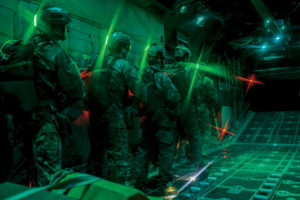
While it’s fair to say that portions of the military textile market are shrinking—the U.S. now has far fewer troops overseas—it is also true that some segments are changing, which is an open door for innovation. Despite a decline in the U.S. Department of Defense (DoD) budget projections, there continue to be opportunities for textile manufacturers that connect with military organizations, monitor trends, stay open to partnerships with academic institutions and other manufacturers, and embrace innovation.
By the numbers
“The military market from our perspective is not as good as it was in 2010 but better than it was in 2013 and 2014, and on par with 2015,” says Geoff Senko, sales representative, MMI Textiles, Cleveland, Ohio, and committee government chair of SEAMS (the National Association for the U.S. Sewn Products Industry).
The Defense Logistics Agency (DLA) 2017 C&T (clothing and textiles) procurement budget has been established at $1.8 billion. “Total acquisition funding in the FY 2017 request is 3.8 percent less in real terms from the level enacted in FY 2016, in part to accommodate the lower level of funding agreed to in the BBA [Bipartisan Budget Act] 2015 budget deal,” according to a report by Todd Harrison, director of defense budget analysis and senior fellow in the International Security Program at the Center for Strategic & International Studies (CSIS) in Washington, D.C.
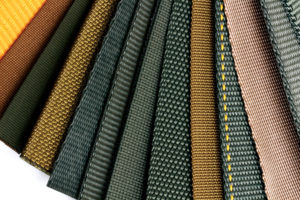
The budget is segmented into two categories: procurement and RDT&E (Research Development Test and Evaluation). “One-third of the DoD budget request, $184.4 billion, is for procurement and RDT&E,” according to Harrison’s report. “Procurement funding generally supports the purchase of weapon systems that have already been developed and are in production, while RDT&E funding is generally used to pay for basic and applied research, technology and component development, and system development.”
Harrison further reports that the RDT&E budget—which is the portion affecting textile manufacturers—has declined more than in previous budget cycles, falling 28 percent in real terms.
New products wanted
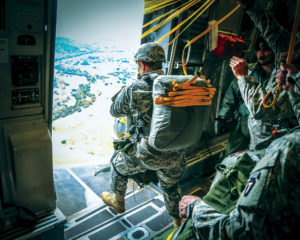
While that number is significant, changes in what types of textile goods the military is looking for open up opportunities for textile manufacturers. “Some services have excess inventory due to the buildup from the two previous wars,” says Carole Winterhalter, textile technologist for U.S. Army’s NSRDEC, Natick, Mass. “In some cases not all has been depleted.”
NATICK and Army DLA are looking for products suited to jungle and arctic climates. “There’s a big focus right now on jungle and arctic military use, which means a push at NATICK and Army DLA to shift army combat uniforms (ACUs) to operational camouflage patterns (OCPs),” Senko says. “We’ve been fighting in the desert for so long that we really don’t have anything on the shelf now for jungle and arctic use. However, they’re only doing the most mission-critical products at the moment: uniforms and field gear.”
MMI, in partnership with Mikan Printing, Mooresville, N.C., launched its new line of MultiCam® printed narrow fabrics in elastic, webbing, binding tape, loop and zipper with jungle prints. “This product has been huge for us, especially with our new patent-pending line that has a blended edge to better blend in with the fabric,” Senko says.
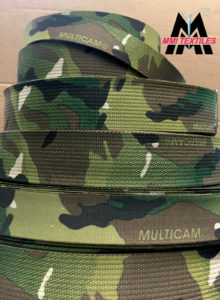
and tactical industries. Photo: MMI Textiles.
ChemBio protective clothing is also in demand. “The Defense Threat Reduction Agency (DTRA) Chemical Biological S&T program is seeking closer ties with manufacturers to address and develop technological approaches for next-generation garments,” says Mary Lynn Landgraf, senior international trade specialist, Office of Textiles and Apparel (OTEXA), U.S. Dept. of Commerce, International Trade Administration (ITA), Washington, D.C. “It is important to note that there is R&D funding available to support these objectives.” (OTEXA works with U.S. textile clients to promote U.S.-made military textiles and end-products around the globe.)
Innovation network
Connecting with organizations that bring together textile industry members, academia and government agencies is a good way to stay current on what the military is looking for and find the proper entities to help bring new products to market. The Advanced Functional Fabrics of America (AFFOA) is a newly launched organization with a mission “to enable a manufacturing-based revolution by transforming traditional fibers, yarns, and fabrics into highly sophisticated, integrated and networked devices and systems.”
AFFOA’s first endeavor is to build a fabric innovation network by partnering with U.S. entities that design, model, measure, supply or integrate fibers, yarns, fabrics and textile products or conduct research for defense and civilian applications. “There’s a tremendous amount of interest [in this project] from high-level individuals and organizations across the country,” Winterhalter says. “Under our first foundational project we’re addressing the lack of modeling, simulation and efficient tools to facilitate predictive design and precision manufacturing for mass-customization products.”
On the home front
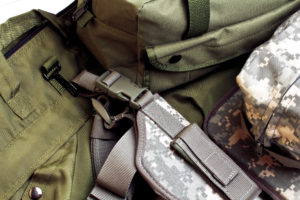
In June 2016 the United States Industrial Fabrics Institute (USIFI), a coalition of U.S. specialty fabric manufacturers and users, along with the Narrow Fabrics Institute (NFI), met on Capitol Hill with representatives from the Department of Commerce and lobbied Congress to ensure that domestic preferences are maintained and strengthened for government purchases that fall under the Berry Amendment (military purchases) and Kissell Amendment (Department of Homeland security purchases). The meetings were organized and facilitated by the organizations’ lobbyists, Lloyd Wood of The Lloyd Wood Group and Sara Beatty of Whitehaven Trade Advisors, both of Washington, D.C.
There were three specific issues that needed to be addressed in the National Defense Authorization Act (NDAA) for the upcoming fiscal year, according to Michael Woody, CEO of Trans-Tex Inc., a narrow web sublimation printing company in Cranston, R.I.
The first issue of concern was that, for the second year in a row, there was an attempt to raise the Simplified Acquisition Threshold (SAT) from $150,000 to $500,000. Any military purchase with a value less than the SAT is exempt from the Berry Amendment and can be sourced overseas. “We were lobbying to keep that business here in the U.S by urging members of Congress to maintain the SAT threshold at its current $150,000 level,” Woody says.
The second issue was the need to eliminate the loophole that allowed athletic footwear used by U.S.
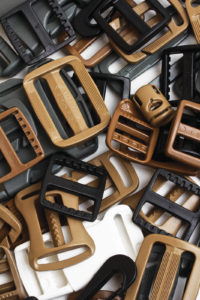
troops to be sourced overseas. “For the last several years, instead of the government procuring footwear from a domestic source, military personnel have been given vouchers that could be used for any sneakers, including those manufactured outside the U.S.,” Woody says. “We lobbied Congress to bring athletic footwear purchases back into line with the Berry Amendment.”
The third issue was wording, inadvertently added to the NDAA, that created ambiguity regarding whether the Berry Amendment would apply to certain commercial items used to fulfill a subset of textile and apparel concerns. If not corrected, this language could be interpreted to allow a much broader range of goods to be sourced overseas instead of from U.S. manufacturers.
“We made progress on all three of these issues and are hopeful that language supporting our priorities will be included in the NDAA,” Woody says. “However, the act is now [as of August 2016] in conference committee so we plan to remain diligent in monitoring the situation on the Hill.”
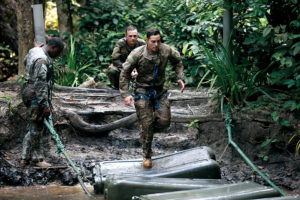
as part of Central Accord 2016, an annual combined, joint military exercise
that brings together partner nations to practice and demonstrate proficiency
in conducting peacekeeping operation. Photo: Sgt. Henrique Luiz de Holleben.
Eye on innovation
As with all industry markets, innovating new fabrics and products is the best chance to get and keep a piece of the military pie. “Keep your eye on innovation because it is the key to the future,” Landgraf says. “AFFOA will be a beacon on developments and requirements for industry for both commercial and military needs. Funding for critical needs will be available. Ideally, manufacturers would want to develop cross-over or hybrid products that offer solutions to both military and commercial markets. This is an important part of keeping the industry relevant, vibrant and lucrative.”
Sigrid Tornquist, a St. Paul, Minn.-based writer and editor, is a frequent contributor to the Review.Turn to page 78 for contact information on sources used in this article.
A 10-step process is recommended for businesses to propose military products to the Department of Defense (DOD):
- Identify your product or service.
- Register your business.
- Identify your target market.
- Identify current DoD procurement opportunities.
- Familiarize yourself with DoD contracting procedures.
- Investigate federal supply schedule (FSS) contracts.
- Seek additional assistance as needed.
- Explore sub-contracting opportunities.
- Investigate DOD small-business programs.
- Market your firm well.
For more online information, visit www.acq.osd.mil/osbp/sb/guide.shtml
“The best way to get in front of opportunities with the military is to come up with something new,” says Geoff Senko, sales representative, MMI Textiles, Cleveland, Ohio, and committee government chair of SEAMS (the National Association for the U.S. Sewn Products Industry). “Anytime you can develop a new product/new fabric/better design, the DoD is going to want to see it.”
After that, Senko says the key is to stay connected. A good way “to get in front of the military is to be at events like IFAI Expo with its military division and SEAMS,” He says. “The biggest thing SEAMS can do for its members is to keep them in the loop. I attend all the trade shows and I bring every opportunity I hear about to the members."
 TEXTILES.ORG
TEXTILES.ORG


